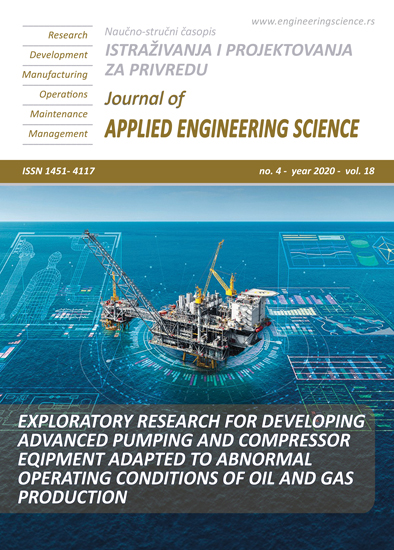SUSTAINABLE MINING TOWARDS ACCOMPLISHING CIRCULAR ECONOMY PRINCIPLES
Abstract
Today human society is already witnessing rapid depletion of non-renewable ore resources. As the distribution of raw material resources globally is very off-balance, and preassure on environment as the consequence of ore exploatation is not negligible, re-utilization and recycling of industrial side-streams gaining on importance. Finding new potentially anthropogenic resources of material (at first place critical raw materials) are inline with sustainable waste management goals, and in correlation with boundaries given by the circular economy principles. Side-streams from mines can become source for recovery of these materials. The aim of this paper was to analyze position of mining waste in correlation with circular economy principles, as well potential for implementation of them within extraction industry in the Republic of Serbia.
References
OECD (2018). Global Material Resources Outlook to 2060.
World Bank (2018). What a Waste 2.0: A Global Snapshot of Solid Waste Management to 2050 https://www.wastedive.com/news/world-bank-global-waste-generation-2050/533031/
https://www.weforum.org/agenda/2020/01/the-world-needs-a-circular-economy-lets-make-it-happen /Accesed: April 25th 2020.
Stanković, S. (2016). Microbial diversity of an extremely acidic lake Robule and effect of the lake water on oxidation of sulfide minerals, Doctoral Dissertation, University of Belgrade, Faculty of Mining and Geology, Belgrade
Kivikytö-Reponen, P., Ulla-Maija, M., Mäkinen, J. (2016). Added value from responsible use of raw materials, VTT Research Highlights 13, ISBN 978-951-38-8498-7, https://www.vttresearch.com/sites/default/files/pdf/researchhighlights/2016/R13.pdf
https://katastarrudarskogotpada.rs /Accessed: 19 May 2019.
European Commission (2018). Report on Critical Raw Materials in the Circular Economy, doi: 10.2873/167813 https://ec.europa.eu/docsroom/documents/27348/attachments/1/translations/en/renditions/native
European Commission (2019). Development of a guidance document on best practices in the Extractive Waste Management Plans Circular Economy Action, doi: 10.2779/061825, https://ec.europa.eu/environment/waste/mining/pdf/guidance_extractive_waste.pdf
Dino, G. A., Mehta, N., Rossetti, P., Ajmone-Marsan, F., De Luca, D. A. (2018). Sustainable approach towards extractive waste management: two case studies from Italy. Resources Policy, 59, 33-43. https://doi.org/10.1016/j.resourpol.2018.07.009.
Radovanović, D. (2017). Stabilization and solidification process of hazardous sludge generated during wastewater treatment process, Doctoral Dissertation, University of Belgrade Faculty of Technology and Metallurgy, Belgrade.
Alivojvodić,V., Kokalj,F., (2018).Upravljanje otpadom I cirkularna ekonomija, text book, Belgrade Polytechnic, Belgrade, ISBN 978-86-7498-077-4.
http://ec.europa.eu/environment/action-programme / Accessed May 19th 2019.
https://www.government.nl/topics/circular-economy/from-a-linear-to-a-circular-economy /Accessed April 17th 2020.
European Commission (2020).A new Circular Economy Action Plan For a cleaner and more competitive Europe, COM 98 final.
Lacy, P., Rutqvist, J. (2015). Waste to wealth: The circular economy advantage, Accenture, Palgrave Macmillan, ISBN 978-1-137-53070-7
Petronijević, N., Stanković, S., Radovanović Ivšić, D., Kamberović, Ž., Sokić, M., Marković, B., Zildzović, S. (2019) Software simulation of the proposed integral treatment of acidic wastewaters and overburden of the Cerovo copper mine. 4th Metallurgical & Materials Engineering Congress of South-East Europe 2019, p. 37-37.
Lottermoser, B. (2010) Mine Wastes: Characterization, Treatment and Environmental Impacts, Third Edition, Springer, p.5, DOI 10.1007/978-3-642-12419-8
Drljača, M. (2015). Koncept kružne ekonomije.Kvalitet&izvrsnost, 4, 18-22, ISSN: 2217-852X; UDC 330.341.
Yiqing, Z., Li, Z., Li, Z., Qin, J. (2012). Discussion on the Model of Mining Circular Economy. Energy Procedia, 16, 438-443, DOI: 10.1016/j.egypro.2012.01.071.
Lebre, E´., Corder,G., Golev,A. (2017). The Role of the Mining Industry in a Circular Economy: A Framework for Resource Management at the Mine Site Level.Journal of Industrial Ecology, 21, 3, 662-672, DOI: 10.1111/jiec.12596.
Blengini, G. A., Mathieux, F., Mancini, L., Nyberg, M.,Viegas, H.M. (2019) Recovery of critical and other raw materials from mining waste and landfills: State of play on existing practices, EUR 29744 EN, Publications Office of the European Union, Luxembourg, ISBN 978-92-76-03391-2, doi:10.2760/494020, JRC116131. https://publications.jrc.ec.europa.eu/repository/bitstream/JRC116131/aaa_20190506-d3-jrc-science-for-policy-ecovery_of_rm_from_mining_waste_and_landfills_4_07_19_online_final.pdf
Dimitrijević, M. (2013). Oksidacija pirita kisele rudničke vode, Tehnički fakultet u Boru, Univerzitet u Beogradu, ISBN 978-86-80987-99-6.
Stevanović,Z. (2012).The leaching of heavy metals from flotation tailings, Doctoral Dissertation, University of Belgrade, Technical Faculty in Bor, Bor.
Pavlović, J., Stopić, S., Friedrich, B., Kamberović, Ž. (2007). Selective Removal of Heavy Metals from Metal-Bearing Wastewater in a Cascade Line Reactor. Environmental Science and Pollution Research, 14, 7, 518-522, DOI: 10.1065/espr2006.09.345.
Moodley, I., Sheridana,C. M., Kappelmeyer, U., Akcild, A. (2017). Environmentally sustainable acid mine drainage remediation: Research developments with a focus on waste/by-products. Minerals Engineering, 126, 207-220, DOI: 10.1016/j.mineng.2017.08.008
Myer, K. (2007) Environmentally Conscious Materials and Chemicals Processing, p. 264, ISBN 987-0-471-73904-3
Geng, Y., Zhang,P., Côté,R.P., Fujita,T. (2009).Assessment of the National Eco-Industrial Park Standard for Promoting Industrial Symbiosis in China. Journal of industrial ecology, 13, 1, 15-26, DOI: 10.1111/j.1530-9290.2008.00071.x.
Van Berkel, R., Fujita,T., Hashimoto,S., Geng,Y. (2009). Industrial and urban symbiosis in Japan: Analysis of the Eco-Town program 1997–2006. Journal of Environmental Management, 90, 3, 1544–1556, DOI:10.1016/j.jenvman.2008.11.010.
Atanacković, N. (2018). Risk assessment of water pollution caused by abandoned mining operations in Serbia, Doctoral Dissertation, University of Belgrade, Faculty of Mining and Geology, Belgrade.
“Official Gazette of the RS” No 76/09 оf 25.10.2019, Rulebook on the criteria for determining of by-products and the form of the by-products report, the method and deadlines for its delivery.
Spasić, N., Stojanović, B., Nikolić, M., (2005).Uticaj rudarstva na okruženje I revitalizacija degradiranog prostora. Arhitektura i urbanizam, 16-17, 75-85, UDK 622.271:502.171.
Dimitrijević, M., Milić, S. (2017). Sulfidni rudarski otpad karakteristike, uticaj na životnu sredinu I tretman, Tehnički fakultet u Boru, Univerzitet u Beogradu, Bor, ISBN 978-86-6305-063-1.
Milićević, S., Milošević,V., Povrenović, D., Stojanović, J., Martinović, S., Babić, B. (2013).Removal of heavy metals from aqueous solution using natural and Fe(III) oxyhydroxideclinoptilolite. Clays and Clay Minerals, 61, 6, 508-516, doi.org/10.1346/CCMN.2013.0610603.
Karanac, M. (2018).The utilization of fly ash modified by calcium hydroxide and ferric oxide for the removal of heavy-metal ions from water, Doctoral Dissertation, University of Belgrade Faculty of Technology and Metallurgy, Belgrade.
Connors, E. (2015). Coal-ash management by U.S. electric utilities: Overview and recent developments. Utilities Policy, 34, 30-33, DOI: 10.1016/j.jup.2015.03.004.
Petronijević, N., Stanković, S., Radovanović, D., Sokić, M., Marković, B., Stopić, S., Kamberović, Ž. (2020) Application of the Flotation Tailings as an Alternative Material for an Acid Mine Drainage Remediation: A Case Study of the Extremely Acidic Lake Robule (Serbia). Metals, 10, 1, 16, doi.org/10.3390/met10010016.
Sokić, M., Radovanović, D., Marković, B., Stojanović, J., Kamberović, Ž., Petronijević, N., Stanković, S. (2019) Treatment of the acidic effluent from a copper smelter by flotation tailings, Hemijska industija, 73, 2, 115-124, doi.org/10.2298/HEMIND181009010S.

